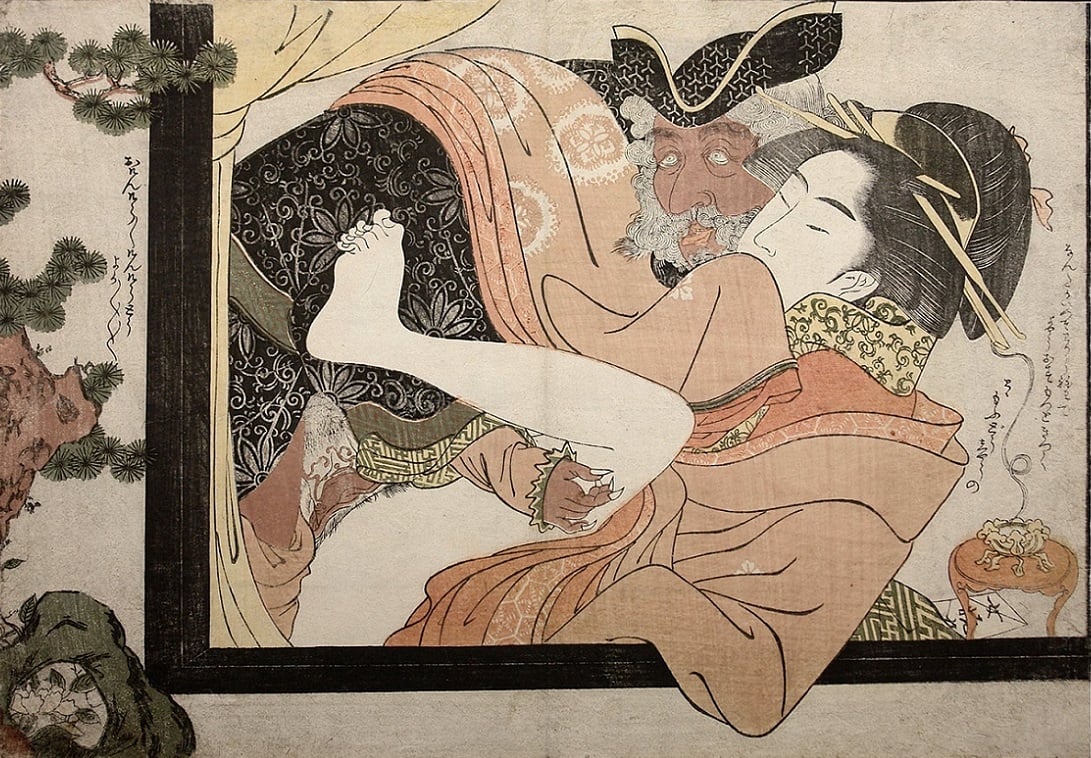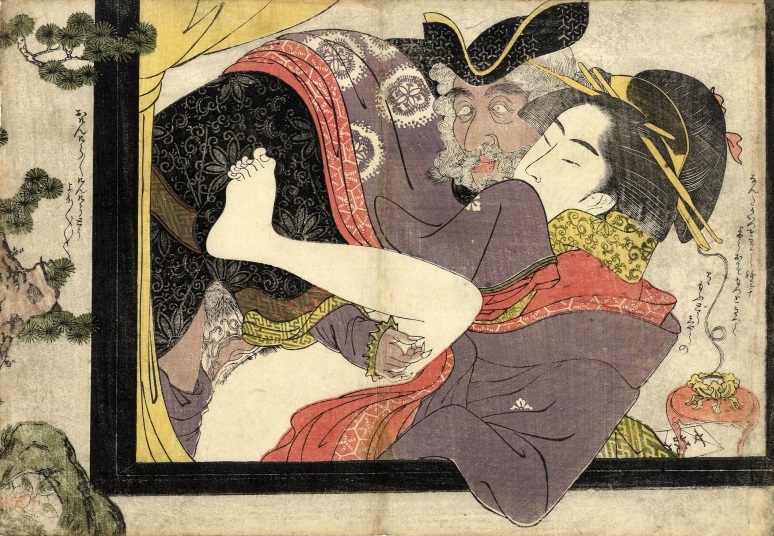
The following oban plate is among the most celebrated shunga designs in ukiyo-e history and is the first tableau of Chõkyõsai Eiri’s acclaimed Models of Calligraphy-series, which was published New Year 1801.
Dutch Captain
Through the window of a brothel in Nagasaki we spy a Dutch captain having sex with a Japanese courtesan. Incense burns in a vessel on the small table to the right, and below it is a small paper sachet which contains an aphrodisiac for women called nyõetsugan. The Dutchman’s eccentricity is emphasized by his deviating physical features such as his “baroque” phallus and his protruding tongue.

Fig.1. ‘Dutch captain and geisha‘ from the series ‘Fumi no kiyogaki (Models of Loving Couples)‘ by ChõkyõsaiEiri (act. c.1789-1801)
Cat-like Fingernails
The Dutchman’s long cat-like fingernails are also a striking detail. Dutch women were not permitted to live at the Dutch trading post on Dejima island near Nagasaki, but Japanese prostitutes were allowed entry to the compound. These Japanese women were known as Oranda-yuki (‘those going to the Dutch’), as opposed to the Kara-yuki (‘those going to the Chinese’) and the Nihon-yuki (‘those going to the Japanese’).
Sexual Entertainment
In theory, the Dutch were forbidden to leave Dejima, even though exceptions were made for sexual entertainment. They frequented the Maruyama, Nagasaki’s licensed pleasure quarter (Vos 1971: 618). Vos cites various senryu poems to demonstrate the role the Maruyama played in the lives of the Dutchmen, so far away from their homeland: Love at Maruyama Bridges a distance of thirteen thousand miles (Vos 1971: 622).” (Excerpts from the book ‘Japanese Erotic Fantasies, Sexual Imagery of the Edo Period’ by Chris Uhlenbeck…etc.)
More comments on this design:
Samurai
“…This page is from a folding album of thirteen images (unusual, as one dozen is the norm) attributed to Chõkyõsai Eiri, a little-known pupil of Hosodai Eishi (1756-1829). Eishi was a military-class (samurai) artist who began his painting career in the government-sponsored Kano school, but left in about 1785 to work in the popular ‘floating-world’, or ukiyo-e, style (cats 56, 57, 87, 117).
Aphrodisiac
“…This idea of brand-name marketing is seen elsewhere in ukiyo-e and shunga, as in the image of a Dutchman and a Japanese prostitute having sex in the album Models of Calligraphy (Fumi mo kiyogaki, New Year 1801; cat.no. 49a) by Chokyosai Eiri (act. c. 1789-1801). In Eiri’s work the aphrodisiac, nyoetsugan, lies just behind the leg of a small chair with burning incense, the characters on its wrapper only partly visible.” (Essay ‘A Flier for the Aphrodisiacal Ointment Chomeigan‘ by Margarita Winkel)
Thereafter, Eishi was rival for paramount fame with Utamaro, though Eishi had the greater number of pupils. Interestingly, in 1800, just months before the image shown here was published, a painting by Eishi was shown to retired monarch Go-Sakuramachi (1740-1813; r. 1762-70), allowing his use of the coveted title ‘Viewed by Heaven’ (tenran)…[…]”
Nagasaki Courtesan
[…]…The scene shows a well-dressed European, surely intended to be a senior Dutch trader, with a Japanese woman, who would be a Nagasaki courtesan. They are both heavily dressed for winter, but she leans out of an open Western-style window, suggesting that they are in the East India Company compound on the island of Dejima (which, of course, Eiri would never have seen). It is elegantly fragranced with burning incense.
The European speaks gibberish, while the woman protests, “I can’t make out what you’re on about. Push it in tighter! What am I to do?’ “. (Timon Screech – Head of the Japanese Section in the Department of Asia at the British Museum, London)
Harlots and Courtesans
“…Eiri’s album opens with one of the most exotic scenes in all shunga. A Dutch kapitan is discovered coupling with a lovely Japanese courtesan, beside a large window opening upon a garden – aphrodisiac incense shown burning languorously at right. The reader of this volume probably does not need to be told that, during most of the Edo Period (1600-1868), the only Occidentals permitted in Japan were the Dutch emissaries and traders – who were restricted to a specially-built island in Nagasaki Bay. Their wives and women were not permitted; but Japanese harlots and courtesans had relatively free access, so this was not exactly a hardship post. Only befittingly for a major seaport, Nagasaki had long been famed for its Maruyama licensed-quarter, one of the largest in West Japan. Thus it was only natural that a special “delivery service” should have been provided for the lonely Dutchmen; and as is manifestly the case in the present scene, the girls often learned to delight in consort with the exotic foreigners.” (Richard Lane)
Barbarians
“…During the long journey from Dejima before finally reaching the artists, tales about foreigners became much exaggerated. The resulting images, thus based on rumors and imagination, usually depicted the ‘barbarians’ in a frightening light, as filthy, with strange habits and long beards, and sometimes with fingernails resembling the talons of birds of prey.” (Ofer Shagan)
Repulsive
“…The album opens with an image showing a Dutchman and a Japanese courtesan making love, framed by a window opening on to a garden. The design perfectly expresses the violent contrast between the delicate image of the Japanese young woman and the repulsive Dutchman – a ‘Southern barbarian’, according to the next. Utamaro’s Poem of the Pillow, on the other hand, closes with the image of a grotesque Dutch couple, depicted clutching each other in a ridiculous sexual embrace.” (Gian Carlo Calza)
Eiri’s design is inspired by eccentric Utamaro’s that you can check out here..!!!
The above piece (Fig.1.) is available in our gallery…!!!
If you have suggestions for subjects within shunga you want to know more about you can leave them in the comment box below!












